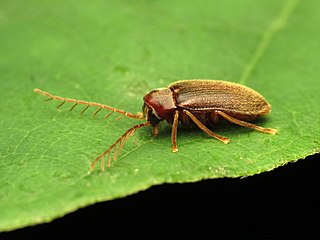
The Reduviidae is a large cosmopolitan family of the suborder Heteroptera of the order Hemiptera. Among the Hemiptera and together with the Nabidae almost all species are terrestrial ambush predators; most other predatory Hemiptera are aquatic. The main examples of nonpredatory Reduviidae are some blood-sucking ectoparasites in the subfamily Triatominae. Though spectacular exceptions are known, most members of the family are fairly easily recognizable; they have a relatively narrow neck, sturdy build, and a formidable curved proboscis. Large specimens should be handled with caution, if at all, because they sometimes defend themselves with a very painful stab from the proboscis.

The Gelastocoridae is a family of about 100 species of insects in the suborder Heteroptera. These fall into two genera, about 15 species of Gelastocoris from the New World and 85 of Nerthra from the Old World. They are reminiscent of toads both in the warty appearance and hopping movements of some species.

Ranatra is a genus of slender predatory insects of the family Nepidae, known as water scorpions or water stick-insects. There are around 100 Ranatra species found in freshwater habitats around the world, both in warm and temperate regions, with the highest diversity in South America and Asia. Fewer are found elsewhere, but include several African, some in North America, three from Australia and three from the Palearctic, notably the relatively well-known European R. linearis. Since Ranatra belongs to the family Nepidae which in turn belongs to the order Hemiptera, ranatrids are considered "true bugs".

The subfamily Aphaeninae is a group of hemipteran insects, especially abundant and diverse in the tropics. They belong to the Fulgoridae (fulgorids), though they are not among the better-known members of that family that are called "lantern bugs" or "lanternflies". In 2009, the first molecular analysis of the Fulgoridae challenged the existing structure of eight currently recognized subfamilies and eleven tribes.

Schizopteridae is the largest family in the infraorder Dipsocoromorpha and comprises 56 genera and approximately 255 species. Schizopterids are some of the smallest (0.5–2.0 mm) true bugs. Members of this family can be distinguished by their small size, enlarged forecoxae and varying degree of abdominal and genitalic asymmetry in males. Schizopteridae exhibit a wide range of simple and complex wing venation patterns. The group is currently divided into three subfamilies: Schizopterinae, Ogeriinae and Hypselosomatinae.

Dysdercus is a widespread genus of true bugs in the family Pyrrhocoridae; a number of species attacking cotton bolls may be called "cotton stainers".

Ptilodactylidae is a family of beetles belonging to the Elateriformia. There around 500 extant species in 35 genera. They are generally associated with riparian and aquatic habitats. The larvae generally live associated with rotting wood or vegetation, or within gravel and detritus on the edge of water bodies. The larvae of some species feed on submerged rotting wood or on plant roots, while the adults of some species are known to feed on fungus with modified brush-like maxillae.

Nerthra is a genus of toad bugs in the family Gelastocoridae. There are at least 90 described species in Nerthra.

Pelocoris is a genus of creeping water bugs in the family Naucoridae. There are about 15 described species in Pelocoris.

Gelastocoris oculatus, the big-eyed toad bug, is a species of toad bug in the family Gelastocoridae. It is found in Central America and North America. Due to their coloration they can be difficult to find. Females lay their eggs under rocks or in sand or mud and both the larva and adults are carnivorous: feeding on other insects along the shorelines.

Anisoscelis is a genus of leaf-footed bugs in the family Coreidae. There are about 11 described species in the genus Anisoscelis.

Heza is a genus of assassin bugs in the family Reduviidae. There are more than 30 described species in Heza found in the Americas.
Gelastocoris rotundatus is a species of toad bug in the family Gelastocoridae. It is found in Central America and North America.

Thaumastocoridae is a family of true bugs in the order Hemiptera. There are about 9 genera and more than 20 described species in the family Thaumastocoridae.

Ochterus is a genus of velvety shore bugs in the family Ochteridae. There are more than 70 described species in Ochterus.

Leptopodidae is a family of spiny-legged bugs in the order Hemiptera. There are about 15 genera and more than 40 described species in Leptopodidae.
2015 in paleoentomology is a list of new fossil insect taxa that were described during the year 2016, as well as other significant discoveries and events related to paleoentomology that were scheduled to occur during the year.
Burmese amber is fossil resin dating to the early Late Cretaceous Cenomanian age recovered from deposits in the Hukawng Valley of northern Myanmar. It is known for being one of the most diverse Cretaceous age amber paleobiotas, containing rich arthropod fossils, along with uncommon vertebrate fossils and even rare marine inclusions. A mostly complete list of all taxa described up until 2018 can be found in Ross 2018; its supplement Ross 2019b covers most of 2019.
Anisoscelis caeruleipennis is a species of leaf-footed bug in the family Coreidae. It was first described by French entomologist Félix Édouard Guérin-Méneville in 1838. Its status as a member of genus Anisoscelis was disputed in 2014.

Flatida is a genus of planthoppers in the family Flatidae and tribe Phromniini. Much of the literature on this genus refers to the name Phromnia, which has recently been recognized to be a junior synonym of Flatida. Species from the genus are found in tropical Africa and Asia.

















